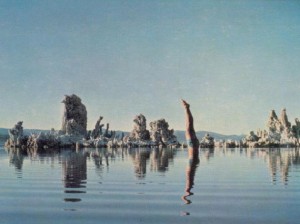On Sunday, July 6, lyricist Polly Samson tweeted out the tantalizing notion that the solo album husband David Gilmour was working on was, in fact, a new Pink Floyd album. Titled The Endless River, it name-checks one of the last lines of the song “High Hopes” from the album The Division Bell. The music was said to have been culled from a 20 minute ambient piece by now deceased keyboardist Richard Wright. It is said to be mostly instrumental, although there have been background vocals added, and longtime collaborator Durga McBroom-Hudson let slip that Gilmour has added a little bit of lead vocal, perhaps with more to come.
On Monday, what was only a hint (from arguably a very good source) was confirmed. The album will be co-produced by Gilmour, Youth, and former Roxy Music guitarist (and co-writer of “One Slip” from A Momentary Lapse Of Reason) Phil Manzanera. As you can imagine, this opens up more questions than answers, and many varied cans of worms.
 End Of The Cease Fire: Live 8 was a terrific moment, back in the 2000s, wasn’t it. All four (then) living and functioning members of the Floyd gathered to do a few songs for a good cause and bury the hatchet. Years later, during his solo tour of The Wall, Roger Waters launched into the celebrated track “Comfortably Numb,” and out of nowhere, on the top of the massive polystyrene brick wall was Gilmour, playing those indelible lines. It was a moment for the ages, a rock and roll detente…
End Of The Cease Fire: Live 8 was a terrific moment, back in the 2000s, wasn’t it. All four (then) living and functioning members of the Floyd gathered to do a few songs for a good cause and bury the hatchet. Years later, during his solo tour of The Wall, Roger Waters launched into the celebrated track “Comfortably Numb,” and out of nowhere, on the top of the massive polystyrene brick wall was Gilmour, playing those indelible lines. It was a moment for the ages, a rock and roll detente…
…that is likely doomed after this announcement. Sure, over the years Floyd albums have come to exist mostly out of mourning or retrospect for lost or displaced members. Both Dark Side of the Moon and Wish You Were Here were, if not completely about, then mostly informed by the mental loss of Syd Barrett, original guitarist/writer for the band. The Division Bell was almost impossibly created out of the Waters vs. re-imagined Floyd stress. This is dictated pretty clearly in the track “Lost For Words.”
I can’t imagine this news has gone down with blessings and well-wishes, and already ideological battle lines are seemingly being drawn. Former Dream Theater drummer Mike Portnoy was quoted as saying that any Floyd recording without Waters is not a real Floyd album. (See, Mike, this is why we cannot have nice things.)
Hard To Visualize: Beyond that, there’s another loss that may be even more difficult to reconcile. That’s the passing of longtime Floyd art designer Storm Thorgerson. Aside from The Wall and The Final Cut, Thorgerson has made the “look” for the band for so many decades. Now, I’m sure he has backlogged tons of work in his day, so it wouldn’t take much to pull some files off the Storm Studios shelf and plug them in. But Thorgerson’s work with Floyd was much different, very analytical, and rather custom-built. Just any picture of small, faceless people interacting with obscenely large objects in the desert will not work. It will look like a slap-together.
 Free As A Bird: Another itch in this sweater is that the instrumental piece this is built around, informally known as “The Big Spliff,” is a Richard Wright performance transfigured post-mortem. While it could never be as creepy and seemingly “wrong” as the post-Lennon Beatles songs “Real Love” and “Free As a Bird,” with the poorly recorded Lennon bounced in to recordings like some sickly apparition, there is the stigma of it all. I don’t believe disrespect was ever intended, but you cannot deny there are issues with coming back with a Pink Floyd album after Wright’s death, and using his work without his stated consent (that we know of).
Free As A Bird: Another itch in this sweater is that the instrumental piece this is built around, informally known as “The Big Spliff,” is a Richard Wright performance transfigured post-mortem. While it could never be as creepy and seemingly “wrong” as the post-Lennon Beatles songs “Real Love” and “Free As a Bird,” with the poorly recorded Lennon bounced in to recordings like some sickly apparition, there is the stigma of it all. I don’t believe disrespect was ever intended, but you cannot deny there are issues with coming back with a Pink Floyd album after Wright’s death, and using his work without his stated consent (that we know of).
Wright had been on the outs with the band many times. He was relegated to little more than a session man on The Wall, was completely off The Final Cut, and was in virtual session man mode again on A Momentary Lapse Of Reason. That doesn’t help things at all.
Waves and Washes: Another thing is that, from most accounts so far, “The Big Spliff” is not a rock piece. You could argue that neither were “The Great Gig In The Sky” or the second complete portion of “Shine On You Crazy Diamond.” You could also argue that the latter was, in part, developed from an ambient project called “Wine Glasses” and that “The Big Spliff” cannot possibly be that far removed from it. All true. We also know that latter Floyd albums were firmly softer rock than what came before. Just how “ambient” this ambient piece is will depend on your investigation. It is apparently a hidden track on the Pulse live recording, but I haven’t found it.
All of this is to say that what people are expecting to get, and what they might likely get, are very far apart from each other. And what might that be, you ask?
 Not So Much Songs: So, if you are into the “song” songs of Pink Floyd and not the instrumental tangents they can be known for (“Echoes” comes to mind), you might be seriously surprised by what The Endless River finally sounds like. Judging from the abstract definition of the title, this could be a rumination on death, the afterlife, or the earthbound existence that goes on after lives go. It may wind up being a very somber piece.
Not So Much Songs: So, if you are into the “song” songs of Pink Floyd and not the instrumental tangents they can be known for (“Echoes” comes to mind), you might be seriously surprised by what The Endless River finally sounds like. Judging from the abstract definition of the title, this could be a rumination on death, the afterlife, or the earthbound existence that goes on after lives go. It may wind up being a very somber piece.
I’m hopeful that it won’t be, and I have more than once defended the validity of the post-Waters Floyd efforts. I’m not giving the thumbs-down on the record before it’s even completed, but I am clear-eyed about the issues that confront it. I hope I’m wrong. I hope that I will enjoy it when it arrives and for years to come. Yet there’s a part of me that, nonetheless, wishes the remnants of the band weren’t bringing it into the canon. In so many ways, it could never comfortably be there.





Comments